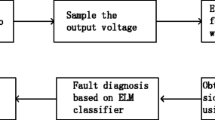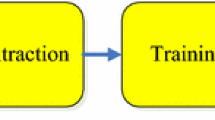Abstract
Diagnosis of incipient faults for electronic systems, especially for analog circuits, is very important, yet very difficult. The methods reported in the literature are only effective on hard faults, i.e., short-circuit or open-circuit of the components. For a soft fault, the fault can only be diagnosed under the occurrence of large variation of component parameters. In this paper, a novel method based on linear discriminant analysis (LDA) and hidden Markov model (HMM) is proposed for the diagnosis of incipient faults in analog circuits. Numerical simulations show that the proposed method can significantly improve the recognition performance. First, to include more fault information, three kinds of original feature vectors, i.e., voltage, autoregression-moving average (ARMA), and wavelet, are extracted from the analog circuits. Subsequently, LDA is used to reduce the dimensions of the original feature vectors and remove their redundancy, and thus, the processed feature vectors are obtained. The LDA is further used to project three kinds of the processed feature vectors together, to obtain the hybrid feature vectors. Finally, the hybrid feature vectors are used to form the observation sequences, which are sent to HMM to accomplish the diagnosis of the incipient faults. The performance of the proposed method is tested, and it indicates that the method has better recognition capability than the popularly used backpropagation (BP) network.
Similar content being viewed by others
References
F. Aminian, M. Collins, Analog fault diagnosis of actual circuits using neural networks. IEEE Trans. Instrum. Meas. 51(6), 544–550 (2002)
P.N. Belhumeur, J.P. Hespanha, D.J. Kriegman, Eigenfaces vs. fisherfaces: Recognition using class specific linear projection. IEEE Trans. Pattern Anal. Mach. Intell. 19(7), 711–720 (1997)
D. Brown, P. Kalgren, C. Byington, Electronic prognostics—a case study using global positioning system (GPS), in Proceedings of the IEEE Autotestcon, Rochester, NY (2005), pp. 832–838
M. Catelani, A. Fort, Soft fault detection and isolation in analog circuits: Some results and a comparison between a fuzzy method and radial basis function networks. IEEE Trans. Instrum. Meas. 51(2), 196–202 (2002)
Y.T. Chan, J.C. Wood, A new order determination technique for ARMA processes. IEEE Trans. ASSP 32(3), 517–521 (1984)
L. Chen, H. Liao, M. Ko, A new LDA-based face recognition system, which can solve the small sample size problem. Pattern Recognit. 33(10), 1713–1726 (2000)
R. Duda, P. Hart, D. Stork, Pattern Classification (Wiley, New York, 2001)
D. Goodman, B. Vermeire, P. Spuhler, Practical application of PHM/prognostics to COTS power converters, in Proceedings of IEEE Aerospace, Big Sky (2005), pp. 3573–3578
P. Howland, M. Jeon, H. Park, Structure preserving dimension reduction for clustered text data based on the generalized singular value decomposition. SIAM J. Matrix Anal. Appl. 25(1), 165–179 (2003)
Z. Huang, Extensions to the K-means algorithm for clustering large data sets with categorical values. Data Min. Knowl. Discov. 2(9), 283–304 (1998)
M. Kirby, L. Sirovich, Application of the Karhunen–Loeve procedure for the characterization of human faces. IEEE Trans. Pattern Anal. Mach. Intell. 12(1), 103–108 (1990)
A. Kundu, G.C. Chen, C.E. Persons, Transient sonar classification using hidden Markov models and neural nets. IEEE J. Ocean. Eng. 19(1), 87–99 (1994)
F. Li, P.Y. Woo, Fault detection for linear analog IC – the method of short-circuits admittance parameters. IEEE Trans. Circuits Syst. I, Fundam. Theory Appl. 49(1), 105–108 (2002)
A.A.K. Mohsen, M.F.A. EI-Yazeed, Selection of input stimulus for fault diagnosis of analog circuits using ARMA model. Int. J. Electron. Commun. 58(3), 212–217 (2004)
L.R. Rabiner, A tutorial on hidden Markov models and selected applications in speech recognition, in Proceedings of the IEEE (1989), pp. 257–286
L.R. Rabiner, B.H. Juang, An introduction to hidden Markov models. IEEE ASSP Mag. 3, 4–16 (1986)
A. Ramakrishnan, M. Pecht, A life consumption monitoring methodology for electronic systems. IEEE Trans. Compon. Packag. Technol. 26(9), 625–634 (2003)
A. Setayeshmehr, A. Akbari, H. Borsi, A procedure for diagnosis and condition based maintenance for power transformers, in Conference Record of the IEEE International Symposium on Electrical Insulation, Indianapolis (2004), pp. 504–507
V. Stopjakova, P. Malosek, V. Nagy, Neural network-based defect detection in analog and mixed IC using digital signal preprocessing. J. Electr. Eng. 57(5), 249–257 (2006)
S.Y. Yang, Fault Diagnosis and Reliability. Design for Analog System (Tsinghua University Press, Tsinghua, 1993)
S.K. Yang, A condition-based failure-prediction and processing-scheme for preventive maintenance. IEEE Trans. Reliab. 52(3), 373–384 (2003)
J. Yang, Y. Xu, C.S. Chen, Human action learning via hidden Markov model. IEEE Trans. Syst. Man Cybern., Part A, Syst. Human 27(1), 34–44 (1997)
J. Ye, R. Janardan, C. Park, An optimization criterion for generalized discriminant analysis on under sampled problems. IEEE Trans. Pattern Anal. Mach. Intell. 26(8), 982–994 (2004)
J. Ying, T. Kirubarajan, K.R. Pattipati, A hidden Markov model-based algorithm for fault diagnosis with partial and imperfect tests. IEEE Trans. Syst. Man Cybern., Part C, Appl. Rev. 30(4), 463–473 (2000)
X.D. Zhang, Y.S. Zhang, Singular value decomposition based MA order determination of non-Gaussian ARMA model. IEEE Trans. Signal Process. 41(8), 2657–2664 (1993)
W. Zhao, R. Chellappa, P.J. Phillips, Subspace linear discriminant analysis for face recognition. Technical Report, Univ. Maryland (1999)
Author information
Authors and Affiliations
Corresponding author
Additional information
This work is supported in part by the defense foundation scientific research fund under Grant A1420061264 and national natural science fund under Grant 60673011.
Rights and permissions
About this article
Cite this article
Xu, L., Huang, J., Wang, H. et al. A Novel Method for the Diagnosis of the Incipient Faults in Analog Circuits Based on LDA and HMM. Circuits Syst Signal Process 29, 577–600 (2010). https://doi.org/10.1007/s00034-010-9160-1
Received:
Revised:
Published:
Issue Date:
DOI: https://doi.org/10.1007/s00034-010-9160-1




